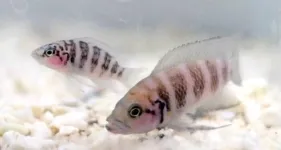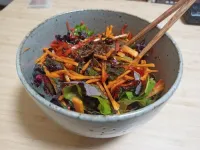(Press-News.org)
Hundreds of thousands more breeding pairs of seabirds could return to remote island archipelagos if invasive rats were removed and native vegetation restored – a new paper finds.
In a first of its kind study, researchers also calculated that there are enough fish in the seas surrounding the remote tropical islands that were the focus of the research within hunting range of seabirds to support these restored populations.
This is an important factor that has not been considered in previous island restoration studies and could become a vital consideration to guide future island restoration projects around the world, researchers behind the study say.
The findings by an international team of marine scientists led by researchers at Lancaster University have been published today by the journal Conservation Biology.
“We know that invasive species, such as rats, have devastating impacts on native seabird populations – they eat the eggs, chicks and even sometimes adult birds,” said Dr Ruth Dunn of Lancaster University and lead author of the study.
“It’s been shown that restoration projects that remove invasive species, such as rats, are effective. However, when there are limited resources in planning island restoration projects it is also important to know if seabird populations are restored that there will be enough fish in the sea for them to hunt and eat - especially as threats such as over-fishing and climate change make fish populations more uncertain.
“Our study was the first to factor in this important consideration and encouragingly for the remote islands we studied we found that there is enough fish in the sea for restored populations of seabirds.”
The researchers calculated the energy requirements of restored seabird populations, and prey fish quantities using available data. The seas surrounding the remote Chagos Archipelago in the Indian Ocean, the focus of the study, include areas of nature reserves where fishing is restricted. These protected areas may have affected the availability of prey fish for restored seabird populations, the scientists say.
“We hope our findings will be an important case study to guide island restoration projects elsewhere, including potentially the consideration of marine protected areas that limit fishing as part of these projects,” said Dr Dunn.
The research team looked at three projected scenarios where invasive rats would be eradicated from 25 islands, and natural habitat, such as native forest and savannah, were restored to different degrees.
Their modelling shows that if rats were removed from these 25 islands that could result in populations of lesser noddies, sooty terns and red-footed boobies recovering to nearly 24,000 breeding pairs – an 18-fold increase.
If native vegetation was restored to half of the surface area of these islands then breeding pairs on these rat-eradicated islands could achieve 83,000 pairs. And if vegetation was restored to three quarters of these islands’ surface area then that could lead to more than 280,000 breeding pairs of lesser noddies, sooty terns and red-footed boobies.
The benefits are not limited to what can be seen on the islands. Previous studies by the research team have shown that seabirds play a critical role in cycling nutrients from the deep ocean onto islands, and then onto adjacent coral reefs surrounding the islands.
The seabirds’ droppings, known as guano, carry nitrogen and phosphorus, important nutrients that leach into the surrounding seas fertilising surrounding coral reef environments.
“Removing invasive predators is vitally important for seabirds to thrive in these tropical island environments, but we also know from previous studies that when we have more seabirds we see positive impacts for coral reefs in the seas surrounding tropical islands,” said Dr Dunn.
The researchers found that the increase in seabird numbers would equate to nitrogen input from seabird droppings increasing from 78 tonnes a year to 170 tonnes a year.
This would provide a huge boost to life under the waves with a 52 per cent increase in fish biomass on the reefs – that equates to around 50,000 tonnes more reef fish around the islands.
In addition, the scientists predict that under these restored conditions there would also be a significant increase in the number of grazing fish, such as parrotfish, doing important jobs such as eating algae and removing dead coral. These roles are critical in helping reefs recover from disturbances such as storms and bleaching events.
“These findings underscore the substantial role island restoration can have not just in bolstering vulnerable seabird populations, but also in enhancing the resilience of adjacent coral reefs to the impacts of climate change,” said Professor Nick Graham of Lancaster University, a co-author of the study.
The marine scientists behind the study say their findings are an important case study to show it is important to consider the wider context when planning resources for island restoration projects. By modelling the impacts of different levels of native vegetation restoration, and available levels of food in surrounding seas, restoration projects can help ensure the best returns for nature.
The research, which was funded by the Bertarelli Foundation, is detailed in the paper ‘Island restoration to rebuild seabird populations and amplify coral reef functioning’.
The paper’s authors are: Dr Ruth Dunn, Dr Cassandra Benkwitt and Professor Nick Graham of Lancaster University; Dr Olivier Maury and Nicholas Barrier from the Université de Montpellier, and Dr Peter Carr of the Chagos Conservation Trust.
END
Figshare, a leading provider of institutional repository infrastructure that supports open research, is pleased to announce that the University of the Witwatersrand Library has chosen Figshare to support its research community with archiving, publishing, sharing and promoting their datasets.
The University of the Witwatersrand (Wits) – a leading research institution in South Africa based in Johannesburg, ranked as the second best university in Africa 2024 (jointly with Stellenbosch University) – will ...
Swedish researchers have surveyed all people under the age of 25 who have had cancer since 1958. The study, led by researchers at Linköping University and Region Östergötland, shows that cancer survivors are at greater risk for cardiovascular diseases, other cancers and other diagnoses later in life. In addition, the researchers saw that socioeconomic factors played a role in survival.
Since 1958, Sweden has registered all cancer patients in the National Cancer Register. Swedish researchers have now used this register to study all cancer survivors who had cancer as a child, adolescent or adult to examine outcomes in later life. The results have been published ...
Osaka, Japan — While there is an increasing consensus among humans that corporal discipline of children does more harm than good, fish may disagree.
Ryo Hidaka, Shumpei Sogawa, Masanori Kohda and Satoshi Awata from Osaka Metropolitan University have demonstrated that a fish species employs physical punishment to elicit helping efforts from their offspring, indicating advanced social and cognitive skills previously thought to be unique to higher vertebrates.
The results of their study were published online in Animal Behaviour on April 6.
For millennia, human societies have used punishment ...
To get high scores at essay writing tests, learners of English as a foreign language need to focus on good arguments more than on complex grammar. The Kobe University finding challenges conventional approaches to test preparation and scoring rubrics.
Writing essays is a well-established tool for monitoring progress in learning English as a foreign language, as it provides a snapshot of a student’s mastery of grammar and vocabulary. Especially in Japan, where English language tests are often required for university admission and students closely follow advice on how to achieve high scores on these tests, a “good essay” is often seen as one that demonstrates ...
The United States’ NASA aims to construct a lunar base through the Artemis program, a manned lunar exploration initiative. However, the practical reality of what general public envision for the space base differs somewhat from well-known science fiction movies. To build a base on the Moon using abundant and diverse construction materials, significant transportation costs are involved. All these materials must be launched from Earth using rockets.
Because transporting construction materials from Earth to the ...
Researchers from the Ontario Drug Policy Research Network (ODPRN) at St. Michael’s Hospital and Public Health Ontario analyzed health data from the Office of the Chief Coroner of Ontario and ICES, and found that there were 210 accidental opioid-related toxicity deaths within shelters between January 2018 to May 2022, with the number of deaths more than tripling during the study period (48 before the pandemic versus 162 during the pandemic).
Statistics Canada data shows that the annual number of emergency beds in Ontario grew by only 15% (6,764 to 7,767) between 2018 and 2022.
“People who use Ontario’s shelter system are not only facing housing instability, but ...
With more working hours and lower average base pay, the well-being of U.S. teachers continues to be worse than that of similar working adults – a consistent pattern since 2021, according to a new RAND survey.
Managing student behavior, low salary and administrative work outside of teaching were the top-ranked sources of stress for teachers in 2024. Teachers reported working an average of 53 hours per week; 15 of these hours – or roughly one quarter of their working hours – were outside of their contracts. This compares to 44 hours per week for similar working adults. Only 36% of teachers said their base pay was adequate compared with 51% of similar ...
An important chapter of the history of human occupation on the coast of Brazil is being rewritten by Brazilian researchers affiliated with the University of São Paulo’s Museum of Archeology and Ethnology (MAE-USP) and supported by FAPESP.
In an article published in the journal PLOS ONE, the group, which also includes researchers in Santa Catarina state, South Brazil, and in other countries (the United States, Belgium and France), shows that the sambaqui builders of Galheta IV, an archeological ...
Researchers from the University of Tokyo performed the first study to quantify highly processed food consumption and to investigate its association with diet quality among Japanese children and adolescents. Highly processed foods (HPFs) accounted for over one-fourth of the total energy intake amongst youths. Consumption was negatively associated with the intake of healthy foods, such as fruits, vegetables and pulses, and positively associated with the consumption of confectioneries.
It's common knowledge that poor-quality diets are considered major risk factors for many health issues and even noncommunicable ...
An international research team has discovered a new way to effectively treat cancer, by using nutrients to reactivate suppressed metabolic pathways in cancer cells.
The researchers used a common amino acid, tyrosine, packaged as a nanomedicine, to change the metabolism of melanoma, a deadly skin cancer, and prevent cancer growth.
Australia has the highest rate of skin cancer in the world. This new approach could be combined with current therapies to better treat melanoma. The technique also has the potential to treat other types of cancer.
The study, Nutrient-delivery and metabolism reactivation therapy for melanoma, was led by Professor Wenbo ...






